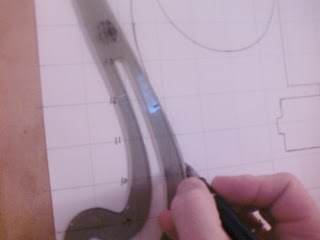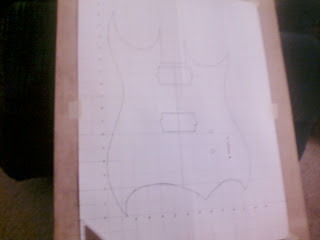This one is a build for my youngest son, Caleb. He's VERY anxious to arrive at a final product.
Getting started, here we are clamping the pieces together. A special thanks to my Dad for giving me the pipe and furniture clamps! A special note, the furniture clamps came from my grandfather who used to reupholster antique furniture. These clamps have got to be close to 100 years old! BEST clamps I've EVER used!
Here I've added the left wing. Again, I clamped the HECK out of it, therefore it's a very tight glue joint. You can NEVER have too many clamps.
Here we have the next wing added and, of course, this is Caleb. He wanted to add the 6 inline headstock because it was more 'pointy', like the guitar body. Kids use strange words, don't they?
Ready for the jigsaw.
He can't stand it, he's got to rock out before it's even got strings! He actually DOES have eyes, he's just smiling too broadly...:).
Here we have a shot of the raised hardtail bridge. No tremolos this time!
The fingerboard is constructed of Red Oak and Abalone inlays are inserted and sanded flat to the surface.
Here is a shot of the truss rod installed. This one is a 1/4" rod and long nut, VERY beefy! A note here, everything you see pictured, constructionwise, was purchased from Home Depot. Do you think they will give me a spot on their next commercial?
I tested the placement of the bridge and neck and it looks like we are spot on!
Now we have added a splash of color.
The white spots are to cover up the dark areas of the Poplar that keep bleeding back through. After all is said and done, we will have 8 coats of acrylic paint.
...And now we have GRAPHICS!!!
I wish I could have taken a picture of Caleb's face when I told him I dropped his guitar and broke it!
...and here we have the 'donor' guitar. It's a Peavey Rockmaster. I tested the pickup and all electronics and they work very well, only the jack crackles a little. That will be taken care of when I transplant the electronics.
...And here we are, after 2 years, finally finished! Here's the stats: Hardtail bridge with accompanying aluminum nut. A single humbucker pickup at the bridge location. Schaller style keys that have been very good with keeping the D'Addario strings tuned. This will be the standard that I will follow with all subsequent guitars.
A close up of the finished product. This guitar is very solidly built and totally SCREAMS!!
Thanks for sticking with the build and God Bless!
















































